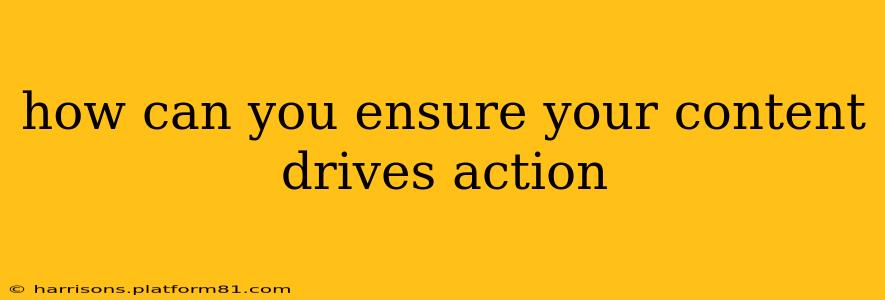How to Ensure Your Content Drives Action: A Guide to Conversion-Focused Content Marketing
Creating compelling content is only half the battle. The ultimate goal is to drive action – whether that's a purchase, a signup, a download, or simply increased brand awareness leading to future conversions. This guide outlines strategies to ensure your content doesn't just inform, but influences.
What Actions Do You Want Your Audience to Take?
Before diving into strategies, define your desired outcomes. What specific actions should your content motivate? Are you aiming for:
- Sales: Driving direct purchases through compelling product descriptions and calls to action.
- Lead Generation: Capturing contact information through forms, sign-ups, or free trials.
- Brand Awareness: Increasing visibility and recognition through engaging storytelling and social media sharing.
- Website Traffic: Driving more visits to your website through strategic SEO and content promotion.
- Engagement: Fostering interaction through comments, shares, and social media participation.
Clearly defining your goals will shape your content strategy and ensure you're measuring the right metrics.
Crafting Compelling Calls to Action (CTAs)
A strong CTA is crucial. Don't assume your audience knows what to do next. Your CTAs should be:
- Clear and Concise: Use action verbs like "Shop Now," "Learn More," or "Download Your Free Guide."
- Visually Appealing: Make them stand out with contrasting colors and compelling design.
- Strategically Placed: Ensure CTAs are visible throughout your content, not just at the end.
- Targeted: Tailor your CTA to the specific content and your audience's needs. A CTA for a blog post about a specific product should differ from one on a general brand awareness piece.
Content Formats That Drive Action
Different content formats lend themselves better to specific actions:
- Case Studies: Showcase successful outcomes and build trust, often leading to inquiries or sales.
- Product Demonstrations/Videos: Allow viewers to see the product in action, boosting engagement and driving purchases.
- Interactive Content (Quizzes, Polls): Engage users and collect data, potentially qualifying leads for future marketing efforts.
- Checklists and Templates: Offer practical value, encouraging downloads and email sign-ups.
- Webinars and Online Events: Provide in-depth information and foster direct engagement with your brand.
Optimizing for Search Engines (SEO)
While not a direct driver of action, strong SEO is crucial for reaching your target audience. Ensure your content:
- Targets Relevant Keywords: Use keywords related to your desired actions and audience searches.
- Is Well-Structured and Readable: Use headings, subheadings, bullet points, and short paragraphs for easy digestion.
- Is Mobile-Friendly: Ensure your content is optimized for viewing on all devices.
- Builds High-Quality Backlinks: Earn links from reputable websites to boost your search ranking.
Using Data to Refine Your Strategy
Analyze your content's performance using analytics tools like Google Analytics. Track metrics like:
- Click-Through Rates (CTR): How often people click on your CTAs.
- Conversion Rates: How many visitors complete your desired action.
- Engagement Metrics: Time on page, bounce rate, shares, and comments.
Use this data to identify what's working and what's not, allowing you to refine your strategy over time.
How Can I Make My Content More Engaging?
Engaging content keeps readers hooked, increasing the likelihood of conversion. Consider:
- Storytelling: Use narratives to connect with your audience on an emotional level.
- High-Quality Visuals: Use images, videos, and infographics to break up text and improve readability.
- Personalization: Tailor your content to specific audience segments.
- Interactive Elements: Incorporate quizzes, polls, and other interactive elements to keep readers involved.
By combining compelling content with strategic CTAs, effective SEO, and data-driven optimization, you can significantly improve your ability to drive action and achieve your marketing goals. Remember, the key is to understand your audience's needs and provide them with valuable content that solves their problems and motivates them to take the next step.
